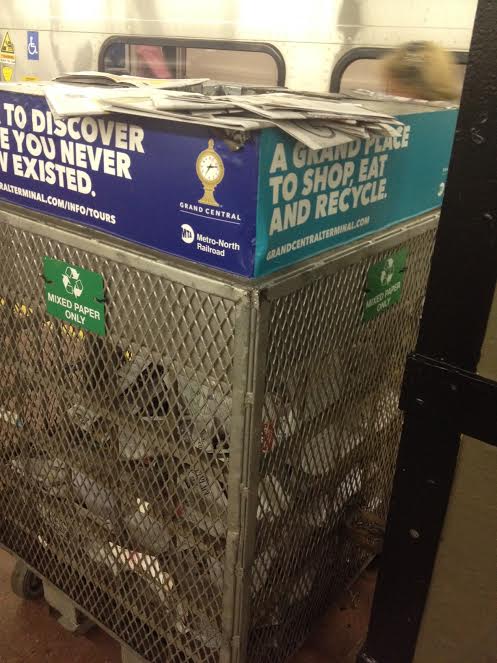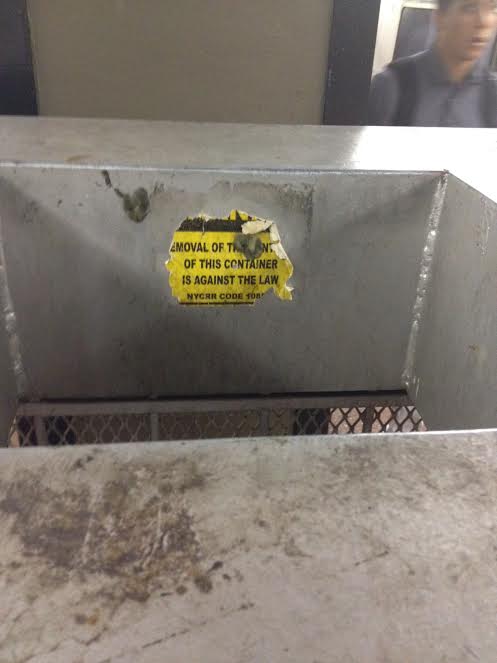All the News that’s Fit to Cage
Manhattan’s Grand Central Terminal has a lot of trains — hundreds come and go each day. Where there are a lot of trains, there are a lot of commuters; in this case, there are well over half a million going in and out of Grand Central each day. And even in today’s digital world, where there are a lot of commuters, there are a lot of newspapers. And when thousands of riders pile off the trains as they enter New York City, many of those newspapers find themselves unlovingly tossed into a recycling bin.
For the New York Times, this was a problem.
It’s not clear when Grand Central Terminal introduced recycling bins to its facilities, but by 2000 or 2001, newspaper-reading commuters had become accustomed to dumping their used papers into those bins. But there were others on those trains — riders who weren’t reading the paper on their commute and, more to the point, weren’t buying the paper. That group had gotten used to a bounty of news waiting for them — for free — at the end of the line. This group would reach into the recycle bins and take a free, used copy of the paper they wanted. In a sense, the papers were recycled much more quickly than anyone had planned.
According to an August 2001 New York Times article (yes, the paper covers its own shenanigans), Metro-North — the agency which operates Grand Central — estimated that in any given morning, “about a ton of newspaper was taken out of bins each morning.” (They meant “ton” literally, too — that’s 2,000 pounds of newsprint and ink.) Metro-North didn’t mind; a spokesperson told the Times that it “never considered [these riders] as moochers or cheapskates” but instead referred to them as “secondary recyclers.” But the Times itself objected, claiming — likely correctly — that many of these “secondary recyclers” were would-be purchasers, and were, therefore, leaving the Times’ coffers a little light.
The solution? At the cost of about $60,000, a collection of contraptions seen below.

That’s a cage-like recycling bin. There’s no way to pull a paper out from the sides, but it’s evident what the bin is intended for. The opening at the top is small, as seen here, allowing for easy disposal but not-so-easy removal by passing commuters. And just in case you want to go diving for the news, there’s a warning — time-worn in the picture below — that “removal of the contents of this container is against the law.”

The cages have persevered over time, even as Grand Central has expanded its recycling capabilities. (Here’s a picture of a newspaper bin near a bottles/cans recycling bin, and as seen here, you’ll note that trash cans at Grand Central look very similar to bottle/can recycling bins. You may also note that I took a lot of pictures of trash and recycling receptacles at Grand Central yesterday, and I wasn’t arrested for suspicious activities. That’s good.)
Whether these cages have helped the Times’ newsprint product remain profitable for a few more years is anyone’s guess. But it didn’t hurt Metro-North’s bottom line — the Times paid the bill to create the containers and, at least as of 2001, was on the hook for their maintenance as well.
Bonus Fact: Metro-North is part of the Metro Transit Authority (MTA), which also runs the city’s subways via an agency called the New York City Transit Authority (NYCTA). And while Metro-North has separate bins for recyclables, NYCTA doesn’t, as seen here. Instead, riders are asked to toss all their litter into the same can, and the MTA figures out the sorting and separation.
The reason? Basically: riders didn’t separate their trash. The city’s website explains: “When NYC started its recycling program in the 1980s, the MTA, in cooperation with the NYC Department of Sanitation, placed recycling containers on a trial basis on the platforms of certain high-traffic stations. They found that riders used recycling containers for both garbage and recyclables, negating the extra effort on everyone’s part. The MTA has determined that the security risks and additional cost of maintaining separate bins with a separate collection system for recyclables is not warranted, and they decided to arrange for post-collection retrieval of recyclable materials from NYC subway platform waste.”
From the Archives: One’s Trash, Another’s Treasure: The black market for brown boxes.
Related: The New York Times on Kindle. So you don’t tempt anyone into “secondary recycling” your newspaper.
